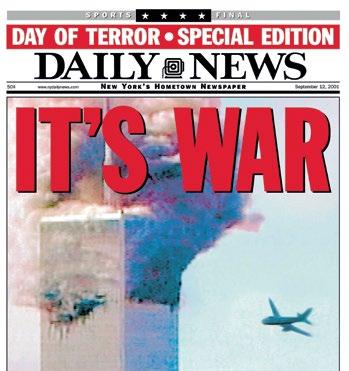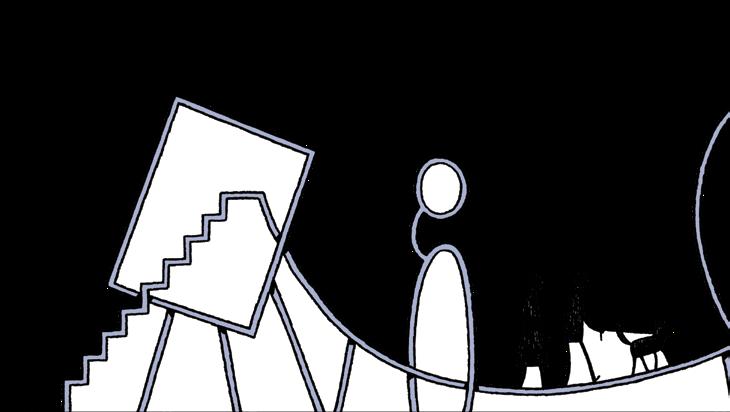
4 minute read
Letter from America
A tale of two atrocities
Twenty years after 9/11, the terrorist horrors are eclipsed by the pandemic edward kosner
Advertisement
I was shaving before going to work that glistening morning 20 years ago, when my all-news radio station suddenly broke in to report that a small private plane had crashed into one of the 110-storey World Trade Center towers at the foot of Manhattan.
I walked into the bedroom, turned on the TV – and witnessed an infamous moment in American history rivalling the firing on Fort Sumter that opened the Civil War, the sneak attack on Pearl Harbor that triggered World War II, and the assassinations of Abraham Lincoln in 1865 and John F Kennedy in 1963.
It was no private plane, of course, but two jet liners commandeered by Saudi Arabian terrorists and turned into lethal missiles which levelled both towers, murdering 2,996 souls and maiming 6,000 others in the first attack on the continental homeland since the British burned the White House during the War of 1812.
A third plane, probably heading for the White House or the US Capitol, plunged into the Pentagon, the headquarters of the American military. Courageous passengers on a fourth hijacked jet rushed the terrorists, and the plane crashed in a Pennsylvania field, killing everyone aboard.
In the stunned aftermath, America experienced a unifying moment unmatched since the defeat of Nazi Germany and Japan a half-century before. Confident news seers proclaimed that American life would be marked for ever by an enduring sense of insecurity. Were they right?
On September 11th 2001, I had other things on my mind. I was the editor-inchief of the New York Daily News. As I rode downtown to the News Building just three miles north of the steaming, reeking pit that became known as Ground Zero, I knew that publishing the next day’s paper would be the greatest test I’d ever faced in a journalism career that had begun 43 years earlier as a kid rewrite-man on the New York Post, barely a mile from what had been the iconic Trade Center towers.
I had endless doubts. Could the staff even get to the newsroom? If they did, could we produce a paper by nightfall? If we managed to transmit the pages to the printing plant across the Hudson in New Jersey, would enough printers show up to run the presses? If they did print the million papers we planned, how could they be distributed with all the bridges and tunnels to and from Manhattan closed?
Still, two things I was certain of. The front page had to be a picture of one of the planes approaching or hitting the towers. And the headline – the ‘wood’ in tabspeak – had to be ‘IT’S WAR’.
The News reporters, columnists and photographers trooped into the office, many caked with ash from the rubble of the collapsed towers. Fired with adrenalin, over the next 12 hours we turned out an 80-page edition. All that was missing was that picture of a plane attacking the towers – and then, at the last minute, it showed up. The presses rolled, the Governor opened the George Washington Bridge for our delivery trucks and those million Daily News copies were snapped up by shaken readers.
Now, two decades later, how accurate
The day after: the front page of the Daily News, edited by Edward Kosner did those cocksure predictions of the impact of 9/11 turn out to be? My headline, ‘IT’S WAR’, was certainly prescient – as I write, President Biden is withdrawing all but a handful of troops from Afghanistan, invaded by the US a month after the WTC attack.
More than 2,300 Americans died in the war and nearly 20 times as many were wounded. The Iraq War started in 2003 and lasted eight and a half years, leaving more than 4,500 Americans dead and nearly 32,000 wounded. Combined, the two wars cost nearly $2 trillion and both could charitably be said to have ended in stalemate.
For a time, 9/11 forged unity in America unmatched since the Second World War. But that ended in recriminations over President George W Bush’s invasion of Iraq, prompted by Saddam Hussein’s phantom weapons of mass destruction.
Conflict over the Iraq War propelled the political rollercoaster that led to the election of America’s first (literally) African-American President. And many believe the backlash sparked by that unprecedented choice thrust the malign Donald Trump into the White House. The result is a nation so polarised that Washington often seems on the cusp of paralysis.
And what of the facile notion that 9/11 for ever deprived Americans of their sense of security in a nation bound by two great oceans and two friendly neighbour nations? True or not, that’s irrelevant now.
The great COVID-19 plague, which has cost more than 600,000 American lives so far and shut down the country for months, destroyed for ever any sense of personal safety anyone here – or around the world – may ever have had.
In that sense, September 11th 2001 now looks smaller in the rear-view mirror than it first appeared.
Besides the New York Daily News, Edward Kosner was the editor of Newsweek, New York magazine and Esquire









